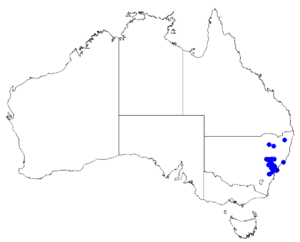Boronia rubiginosa facts for kids
Quick facts for kids Boronia rubiginosa |
|
|---|---|
| Scientific classification | |
 |
|
| Occurrence data from Australasian Virtual Herbarium |
Boronia rubiginosa is a special plant found only in New South Wales, Australia. It belongs to the citrus family, called Rutaceae. This plant is a type of shrub. It has interesting leaves that look like feathers (called pinnate). The underside of its leaves is lighter in color. You can spot its pretty pale to bright pink flowers. Each flower has four petals and grows where the leaves meet the stem.
Contents
What Boronia rubiginosa Looks Like
Boronia rubiginosa is a shrub that can grow up to 2 meters (about 6.5 feet) tall. Its small branches can be a bit hairy.
Leaves and Their Shape
The leaves of this plant are pinnate. This means they have several smaller leaf parts, called leaflets, arranged along a central stem, like a feather. Each leaf has between three and seven leaflets. These leaflets can be oval or shaped like a spatula. The bottom side of the leaflets is always paler than the top.
A whole leaf can be from 8 to 46 millimeters long and 4 to 35 millimeters wide. The stem that holds the leaf (called a petiole) is usually 1 to 12 millimeters long. The leaflet at the very end of the leaf is usually 4 to 23 millimeters long and 3 to 10 millimeters wide. The leaflets on the sides are a bit shorter and narrower.
Flowers and Their Parts
The flowers of Boronia rubiginosa are pale to bright pink. They are also covered in soft, woolly hairs. You'll usually find up to three flowers growing together where a leaf joins the stem.
Each group of flowers grows on a small stalk called a peduncle, which is 2 to 8.5 millimeters long. Each individual flower sits on an even smaller stalk called a pedicel, about 3 to 10 millimeters long.
The flowers have four sepals, which are like small, leaf-like parts that protect the bud. These sepals are egg-shaped or triangular, about 2 to 3 millimeters long. There are also four petals, which are the colorful parts of the flower. These petals are 6 to 11 millimeters long and 3 to 4.5 millimeters wide.
Inside the flower, there are eight stamens. These are the parts that produce pollen. They are different lengths, with some being slightly longer than others.
When It Flowers and Fruits
Boronia rubiginosa usually blooms from July to November. After the flowers, the plant produces a fruit. This fruit is a capsule, which is a dry fruit that splits open when ripe. It can be smooth or very hairy, and it's about 4 to 6 millimeters long and 3 to 3.5 millimeters wide.
How Boronia rubiginosa Got Its Name
The plant Boronia rubiginosa was first discovered and described by a botanist named Allan Cunningham. His description was officially published in 1837 by Stephan Endlicher in a book about plants. Cunningham found the first example of this plant, called the type specimen, near the Hunter River.
The second part of the plant's name, rubiginosa, comes from a Latin word. It means "rusty," which might refer to the color or texture of some part of the plant.
Where Boronia rubiginosa Lives
Boronia rubiginosa grows in dry woodlands. It prefers areas with sandstone soil. You can find it in New South Wales, Australia, specifically between Berrima and Lees Pinch in the Goulburn River National Park.
Another plant, Boronia ruppii, used to be considered the same species as Boronia rubiginosa. However, scientists later found that Boronia ruppii is a different plant. It grows on a special type of rock called serpentite in the Barraba area.

